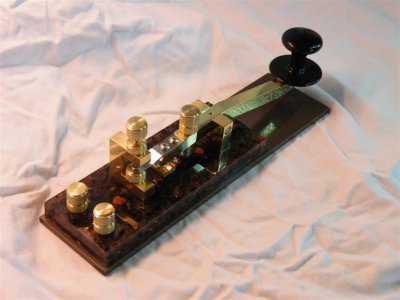-
Welcome back Guest! Did you know you can mentor other members here at H-M? If not, please check out our Relaunch of Hobby Machinist Mentoring Program!
You are using an out of date browser. It may not display this or other websites correctly.
You should upgrade or use an alternative browser.
You should upgrade or use an alternative browser.
Telegraphy Key
- Thread starter edko
- Start date
- Joined
- Jun 15, 2011
- Messages
- 19
Thanks Paul... Yes I do but I need to get better at it. I qualified for my Amateur Extra license at 21 WPM in 1984 during the final testing administered by the FCC in Colorado. I have been inactive for many years and making this key (and one other. a single lever paddle), is my incentive for getting my comprehension and speed up to a reasonable level. Right now I have about 75% comprehension at 15 WPM. I want to achieve at least a solid 80% at 18 WPM before I get back on the air.
Ed - ad7gr
Ed - ad7gr
- Joined
- Jun 15, 2011
- Messages
- 19
Paul... The FCC dropped the code requirement on Dec 15th 2006. Rumor had it that code would die off but it is more popular than ever now and is very much alive. I have a friend that routinely communicates at 40 WPM and up.
John... Neat photo of the N. Korean station... don't often get a chance to look behind the lines there.
Thanks Dave... The long, thin part of the base is painted steel and the shorter, thicker part is made of Avonite, a Solid Surface material used for counter tops.
Ed
John... Neat photo of the N. Korean station... don't often get a chance to look behind the lines there.
Thanks Dave... The long, thin part of the base is painted steel and the shorter, thicker part is made of Avonite, a Solid Surface material used for counter tops.
Ed
- Joined
- Jan 22, 2011
- Messages
- 8,031
Very nice key. I've been looking for a good set of plans to build one, or design my own. Haven't had time lately though.
- Joined
- Jan 22, 2011
- Messages
- 8,031
Oh, it'll be a wintertime project, one of several I'm sure. I have a Tempo One that I want to try it on.
- Joined
- Jun 15, 2011
- Messages
- 19
I'm not sure quite what you mean by a "practice unit"... The only keys I could have called practice keys were the toys that were sold for practice with buzzers and lights on them. Usually bugs and paddles are hi speed keys... the paddle/keyer combination getting up to and far beyond the 40 WPM range. The straight keys, similar to the one I posted, are limited to around 25-30 wpm and lower. That being said someone will come and let me know they achieve faster speeds with one. I really don't know what the normal operator speed is on these keys. I'm just making an educated (wild) guess.
In response to the other post... Have fun with your Tempo One... It's neat to see the glow of the finals.
In response to the other post... Have fun with your Tempo One... It's neat to see the glow of the finals.


